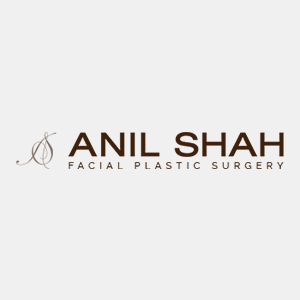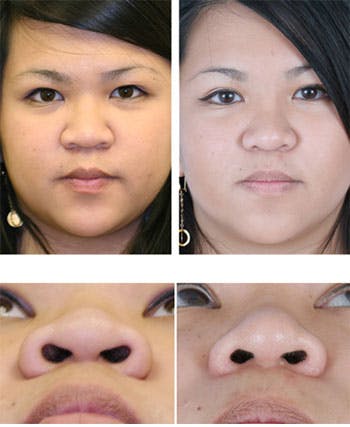
Asian Rhinoplasty | Cosmetic Surgeon Dr. Anil R. Shah
ASIAN RHINOPLASTY IN CHICAGO, IL
Asian Rhinoplasty represents the art of reshaping a nose of Asian ethnicity while maintaining the ethnic identity. I have found that although the use of nasal implants with artificial material is quite common, it leads to an artificial harsh appearance to the nose. In addition, some patients complain about artificial implants causing pain, mobility, and they can actually extrude from the nose.
My philosophy of Asian noses is to preserve many of the ethnic features of the nose and make a nose which has softer highlights and looks natural. I do not use artificial implants because I believe that they do not create a good looking nose, can lead to infection and rejection by the body. I only use natural materials from a person’s own body such as nose cartilage, ear cartilage or costal cartilage and create a nose which is softer looking in appearance, durable and natural.
The difficult nature in that what I do takes longer than placing an implant. Each portion of cartilage is precisely carved and placed so that the nose will be as supported and look as good as possible. It is much more technically difficult than the use of a nasal artificial implant. I have two scientific papers highlighting the areas where surgeons can carve grafts more effectively.
Nonsurgical Rhinoplasty in Asian Patients
 Before and after photos of patient of Dr. Shah’s
Before and after photos of patient of Dr. Shah’s
Nonsurgical rhinoplasty is a common procedure for Asian patients who desire augmentation to the bridge of the nose. In some cases, the tip can be augmented as well with less precision. Filler has the advantage of not needing surgery, avoiding a grafting site, and immediate results. Some of the advances in facial fillers have made it a much better options than just a few years ago.
In the nose, Radiesse is the number one injectable filler in Asia. However, Radiesse represents a poor choice in the nose as it is not reversible and can lead to unevenness of the soft tissues of the nose. Juvederm Ultra Plus is another option for patients but the product tends to be slightly softer than ideal and does not last as long as Voluma. Voluma is currently my preferred product for augmentation of the nose. In some patients it can lead to years of augmentation rather than months. It is a firmer product and can be reversed, making it safer for some patients.
FREQUENTLY ASKED QUESTIONS
Does Dr. Shah prefer filler in the nose or cartilage in the nose?
For permanent changes in the nose, cartilage is a better choice for most patients and is cost effective.
If I had a rhinoplasty performed elsewhere can I place filler on top of my bridge?
It depends. Patients with artificial implants should not have filler placed or do so at risk for infection of the implant. Patients with their own cartilage (such as rib/ ear / septum) can have filler with much improved safety profile.
Does filler last longer in patients with already augmented bridges?
Yes, filler seems to last longer as the product over time is found in histologic studies at 1 year and beyond to turn into collagen (aka scar tissues). This makes filler a good choice for patients with minor imperfections of the nose in an already operated nose (without an artificial implant).
Una publicación compartida de Anil Shah MD (@shahaesthetics) el
Which cartilage is best for the bridge? Is septal cartilage better than rib or ear?
The best cartilage for the nasal bridge for large amount of augmentation is either rib or septal cartilage. This is because septal and rib cartilage are both hyaline cartilage which tends to be straighter and stiffer. Ear cartilage is an OK option but can have some curvature to it, do to its elastic nature.
Does Dr. Shah perform rib cartilage often in Asian Rhinoplasty?
When necessary, rib cartilage helps the nose add structure and improves the shape of the nose. Septal cartilage is often sufficient for patients not seeking large changes to the bridge of the nose.
Can my alar base be reduced as well?
Yes, the alar base reduction is an option, especially for patients with thick skin. Removal of excess skin can help relieve the nose of a thick skin burden and allow for patients a more rapid healing of the nose.
Is there a limit of how much my nose can be projected and raised?
Yes, the limit is how much the soft tissues of the nose will allow. With rib cartilage, large changes of the nose can be made.
Is Voluma safer than Radiesse in the nose?
Voluma is reversible product which does not seem to stick to the soft tissues of the nose. Radiesse can be stick to the undersurface of the nose and can lead to slight contour changes which are difficult to repair.
Why would Dr. Shah inject facial filler in my nose?
Dr. Shah is an expert in rhinoplasty and facial fillers so for patients, they are getting the best of both worlds in their experience. Nonsurgical rhinoplasty involves use of fillers placed appropriately and to create an aesthetically pleasing noses.
What are some common mistakes of other injectors placing filler?
Some injectors place the product too superficial which is potentially dangerous as this plane is where the blood vessels exist and can lead to necrosis of the skin and other complications. In addition, since filler is soft, many patients injected will notice over time that there nose looks too wide. Dr. Shah accounts for these changes to create a raised bridge which looks appropriate for facial proportion.
How long does filler last in the nose?
Filler can last in some patients over 2 years. The reason filler lasts so long in the nose is that in most patients there is not movement associated here. In locations where the face moves such as the smile lines, filler often lasts 6 months or less.
Does Dr. Shah perform revision surgery on Asian rhinoplasty?
The most common issue he sees is over rotation of the nose and failure to project the nasal tip. He often needs rib cartilage in revision cases.
When will my Asian rhinoplasty look good?
Most patients appear ready for work in 1 week after surgery and begin to like their nose at 1 month. Final healing of the nose takes between 1 to 3 years.


